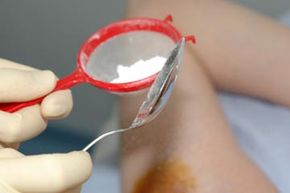If you suspect a sweat test involves a grueling workout, then we've got news for you: This relatively simple test -- performed most often on children -- helps doctors diagnose cystic fibrosis (an inherited disorder marked by frequent lung infections) and has nothing to do with moving around.
In fact, to perform the sweat test -- also known as an iontophoretic sweat test -- a person must sit relatively still. A medicated gel is applied to skin on the arm or leg. Then, via two insulated wires, a specialized machine sends mild electrical currents -- one positive, one negative -- to the medicated gel sites. The gel, along with the electrical current, helps stimulate sweat glands. Although testing isn't painful, it can be uncomfortable for children who don't like the tingling sensation caused by electrodes -- or who aren't accustomed to sitting still for very long. On the upside, the test doesn't require any special preparations, and the $200 to $400 testing cost is usually covered by health insurance.
Advertisement
Once the electrodes are removed, a small caplike device is taped to the skin, where it serves as a sweat collector. The process, from start to finish, usually takes about 30 minutes to an hour, and the affected area may continue to sweat or appear reddened for several hours. Meanwhile, the collected sweat is sent to a laboratory for analysis. The idea is to see whether there are elevated amounts of sodium and chloride in the sweat; people with cystic fibrosis commonly have excessively salty perspiration marked by high levels of chloride.
Cystic fibrosis, which is the most common inherited disease in the United States, usually develops during the first year of life. Adults comprise only about 3 percent of cystic fibrosis diagnoses. As much as 15 percent of all positive sweat tests are false positives, incorrectly revealing cystic fibrosis. That's why it's common practice to repeat positive sweat tests, usually within a day or two of the original testing. It's also a good idea to have the testing performed at a center with specialized experience in collecting sweat. Those expertises usually result in more accurate diagnosis.
Unfortunately, interpreting the results gets more complicated if the person being tested isn't in the optimal age range: three months or older, until adulthood. Newborn babies are difficult to test because they don't normally produce enough sweat to measure sodium and chloride levels. Many adults already have higher concentrations of chloride in their sweat, sometimes leading to false positive results.
In addition to difficulties posed by age, several conditions may cause false positive results, such as hypothyroidism, chronic swelling, certain types of diabetes, anorexia nervosa or Addison's disease. Thanks to its ease of use and inexpensive cost, a sweat test has become a standard means to measure a person's likelihood of having cystic fibrosis, but a positive test will likely prompt a physician to order genetic testing to confirm the presence of any cystic fibrosis gene mutations.
Advertisement

